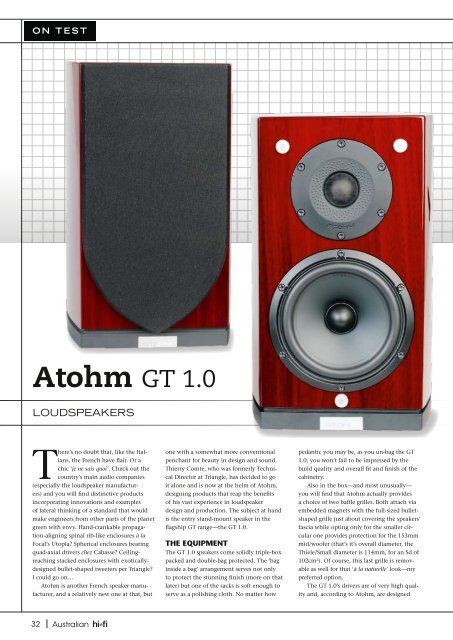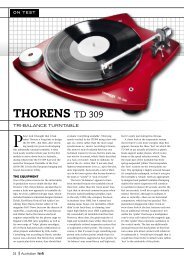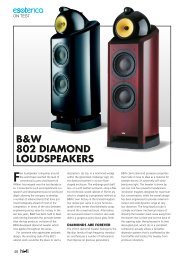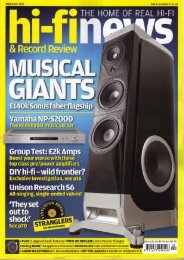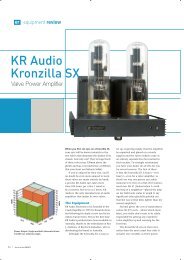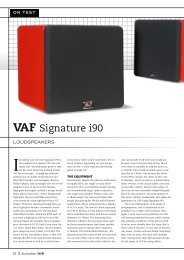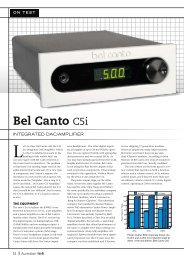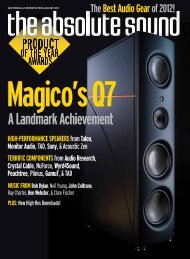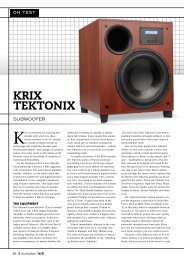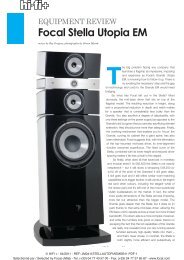Atohm GT 1.0 - Ultra High-End Audio and Home Theater Review
Atohm GT 1.0 - Ultra High-End Audio and Home Theater Review
Atohm GT 1.0 - Ultra High-End Audio and Home Theater Review
Create successful ePaper yourself
Turn your PDF publications into a flip-book with our unique Google optimized e-Paper software.
O N T E S T<br />
<strong>Atohm</strong> <strong>GT</strong> <strong>1.0</strong><br />
LOUDSPEAKERS<br />
There’s no doubt that, like the Italians,<br />
the French have flair. Or a<br />
chic ‘je ne sais quoi’. Check out the<br />
country’s main audio companies<br />
(especially the loudspeaker manufacturers)<br />
<strong>and</strong> you will find distinctive products<br />
incorporating innovations <strong>and</strong> examples<br />
of lateral thinking of a st<strong>and</strong>ard that would<br />
make engineers from other parts of the planet<br />
green with envy. H<strong>and</strong>-crankable propagation-aligning<br />
spinal rib-like enclosures à la<br />
Focal’s Utopia? Spherical enclosures bearing<br />
quad-axial drivers chez Cabasse? Ceilingreaching<br />
stacked enclosures with exoticallydesigned<br />
bullet-shaped tweeters per Triangle?<br />
I could go on…<br />
<strong>Atohm</strong> is another French speaker manufacturer,<br />
<strong>and</strong> a relatively new one at that, but<br />
one with a somewhat more conventional<br />
penchant for beauty in design <strong>and</strong> sound.<br />
Thierry Comte, who was formerly Technical<br />
Director at Triangle, has decided to go<br />
it alone <strong>and</strong> is now at the helm of <strong>Atohm</strong>,<br />
designing products that reap the benefits<br />
of his vast experience in loudspeaker<br />
design <strong>and</strong> production. The subject at h<strong>and</strong><br />
is the entry st<strong>and</strong>-mount speaker in the<br />
flagship <strong>GT</strong> range—the <strong>GT</strong> <strong>1.0</strong>.<br />
The Equipment<br />
The <strong>GT</strong> <strong>1.0</strong> speakers come solidly triple-box<br />
packed <strong>and</strong> double-bag protected. The ‘bag<br />
inside a bag’ arrangement serves not only<br />
to protect the stunning finish (more on that<br />
later) but one of the sacks is soft enough to<br />
serve as a polishing cloth. No matter how<br />
pedantic you may be, as you un-bag the <strong>GT</strong><br />
<strong>1.0</strong>, you won’t fail to be impressed by the<br />
build quality <strong>and</strong> overall fit <strong>and</strong> finish of the<br />
cabinetry.<br />
Also in the box—<strong>and</strong> most unusually—<br />
you will find that <strong>Atohm</strong> actually provides<br />
a choice of two baffle grilles. Both attach via<br />
embedded magnets with the full-sized bulletshaped<br />
grille just about covering the speakers’<br />
fascia while opting only for the smaller circular<br />
one provides protection for the 153mm<br />
mid/woofer (that’s it’s overall diameter, the<br />
Thiele/Small diameter is 114mm, for an Sd of<br />
102cm²). Of course, this last grille is removable<br />
as well for that ‘à la naturelle’ look—my<br />
preferred option.<br />
The <strong>GT</strong> <strong>1.0</strong>’s drivers are of very high quality<br />
<strong>and</strong>, according to <strong>Atohm</strong>, are designed<br />
32 Australian
<strong>Atohm</strong> <strong>GT</strong> <strong>1.0</strong> Loudspeakers<br />
O N T E S T<br />
in-house. Both the tweeter <strong>and</strong> the mid/<br />
woofer have large magnet structures <strong>and</strong><br />
good materials quality. The 28mm aluminium<br />
dome tweeter is ferro-fluid-cooled <strong>and</strong> its<br />
high-frequency response is quoted to extend<br />
up to 30kHz. The solid machined aluminium<br />
faceplate in which the tweeter is housed has<br />
a shallow flare which is dimpled in a precise<br />
pattern—<strong>Atohm</strong> calls it an ‘Anamorphic<br />
Dispersion Pattern’ (ADP)—<strong>and</strong> says this<br />
technique provides ‘better off-axis dispersion<br />
characteristics.’ The mid/woofer features a<br />
cellulose fibre diaphragm with a rubber roll<br />
surround of specific profile (Low Diffraction<br />
Surrounding (LDS)).<br />
A wide <strong>and</strong> open<br />
soundstage spreading<br />
well beyond the speakers’<br />
edges, very good depth,<br />
<strong>and</strong> precisely-placed<br />
images...<br />
Its low-frequency performance is assisted<br />
by means of the enclosure being a bass<br />
reflex alignment, using a rear-facing port<br />
(43Ø×150mm).<br />
<strong>Atohm</strong> specifies the <strong>GT</strong><strong>1.0</strong>’s response as<br />
45Hz to 30kHz with no dB latitudes, its sensitivity<br />
at 89dBSPL at a distance of one metre<br />
for an input level of 2.83V <strong>and</strong> a 6Ω nominal<br />
impedance. The crossover between the drivers<br />
is quoted as being at 2.5kHz. Good-quality<br />
binding posts are featured around the rear<br />
<strong>and</strong> are placed just below a large rotary knob<br />
which allows tweeter level trimming of ±1dB<br />
for fine-tuning to room acoustics.<br />
This is a stunning-looking little transducer:<br />
My review samples were dressed in<br />
an immaculately-applied gloss lacquer over<br />
gorgeous Rosewood. The <strong>GT</strong> <strong>1.0</strong> is also available<br />
in black <strong>and</strong> white piano gloss (I saw an<br />
example of the white gloss at the distributor’s<br />
warehouse, <strong>and</strong> it was absolutely stunning).<br />
I quickly found that the <strong>GT</strong> <strong>1.0</strong> needed<br />
a bit of running-in with the tweeter sounding<br />
a tad forward <strong>and</strong> sibilant <strong>and</strong> the bass a<br />
bit lean straight out of the box. Given some<br />
moderate level music playback for a break-in<br />
period of around 50 hours tamed <strong>and</strong> loosened<br />
things up remarkably. In fact the bass<br />
ended-up being surprisingly full for a speaker<br />
of its size (that huge magnet pays dividends).<br />
La Musique<br />
We have all heard the term ‘disappearing<br />
act’ when it comes to speakers… hell, some<br />
of us lucky ones have even experienced it.<br />
Well the <strong>GT</strong> <strong>1.0</strong>s certainly are the archetypal<br />
summation of that term. These speakers<br />
project a slightly forward soundscape that<br />
is totally independent of the enclosures; to<br />
the point of tricking the ear-to-eye information<br />
process. But you expect this from small<br />
st<strong>and</strong>-mount speakers, right? Well… yes. But,<br />
boy, these <strong>Atohm</strong>s perform that trick well.<br />
The soundscape was an amalgam of a wide<br />
<strong>and</strong> open soundstage spreading well beyond<br />
the speakers’ edges, very good depth, <strong>and</strong><br />
precisely-placed images.<br />
Also impressive for a small speaker was<br />
the h<strong>and</strong>ling of complex <strong>and</strong> dynamic<br />
material. The <strong>GT</strong> <strong>1.0</strong> was adept at dynamic<br />
contrast—more notably in the bass—in a way<br />
akin to larger designs; quite remarkably,<br />
actually, for such a small driver.<br />
Any Rodrigo y Gabriela track came<br />
across with the couple’s signature<br />
ATOHM <strong>GT</strong> <strong>1.0</strong><br />
LOUDSPEAKERS<br />
Br<strong>and</strong>: <strong>Atohm</strong><br />
Model: <strong>GT</strong> <strong>1.0</strong><br />
Category: Bookshelf Loudspeakers<br />
RRP: $4,990<br />
Warranty: Two Years<br />
Distributor: Absolute Hi<strong>End</strong><br />
Address: PO Box 370, Ormond VIC 3204<br />
(04) 8877 7999<br />
info@absolutehiend.com<br />
www. absolutehiend.com<br />
• Superb mids<br />
• Fit ‘n finish<br />
• Can tailor tweeter’s<br />
response<br />
• Impedance<br />
• Deep bass<br />
• No bi-wire<br />
LAB REPORT<br />
Readers interested in a full technical<br />
appraisal of the performance of the<br />
<strong>Atohm</strong> <strong>GT</strong> <strong>1.0</strong> should continue on<br />
<strong>and</strong> read the LABORATORY REPORT<br />
published on page 99. Readers should<br />
note that the results mentioned in<br />
the report, tabulated in performance<br />
charts <strong>and</strong>/or displayed using graphs<br />
<strong>and</strong>/or photographs should<br />
be construed as applying only<br />
to the specific sample tested.<br />
Lab Report on page 99<br />
avhub.com.au<br />
33
O N T E S T<br />
<strong>Atohm</strong> <strong>GT</strong> <strong>1.0</strong> Loudspeakers<br />
power <strong>and</strong> dexterity relatively intact. And<br />
while coping remarkably well with such<br />
difficult material in terms of dynamic<br />
fidelity, the driver duo also excelled at<br />
detail retrieval, instrument separation<br />
<strong>and</strong> accuracy to harmonic structure. It’s<br />
a fast sound too, with a sense of bee-bop<br />
pace that jets the music along, while the<br />
transient snap <strong>and</strong> vivid micro-dynamic<br />
detail on tap here renders small fingernail<br />
<strong>and</strong> steel string interactions dramatically<br />
real-sounding.<br />
In my test room, which is rather<br />
large, I perceived the speakers’ upper<br />
range to be a tad laid-back, or recessed.<br />
The rear tweeter level adjustment was<br />
very useful here <strong>and</strong> adjusting it appropriately<br />
served to add a bit of sparkle<br />
to the upper frequencies. I notched it<br />
up to the +1 position <strong>and</strong> heard a subtle<br />
but easily-perceptible increase in treble<br />
detail <strong>and</strong> extension.<br />
This level of overall sophistication<br />
<strong>and</strong> resolution will place some dem<strong>and</strong>s<br />
on your ancillary gear. As with any great<br />
speaker, the playback source <strong>and</strong> driving<br />
amplification need to be on-par. Also, I’d<br />
recommend that very solid, good-quality<br />
st<strong>and</strong>s, of appropriate height, are<br />
absolutely essential in order to place<br />
that top-notch tweeter at ear height <strong>and</strong><br />
for its proper integration with the equally<br />
adept mid/bass driver. Also worthy of<br />
note is that as much as it’s one hell of a<br />
little driver, so that it can’t defy physics,<br />
it punched less like a welter-weight <strong>and</strong><br />
more like a middle-weight. So what it does<br />
do is quite remarkable.<br />
Conclusion<br />
I was quite taken by the little <strong>Atohm</strong> <strong>GT</strong><br />
<strong>1.0</strong>. It is very refined in its h<strong>and</strong>ling of<br />
tonal colours <strong>and</strong> delicate detail. Its amazing<br />
sound-staging capabilities surprised<br />
me any number of times <strong>and</strong> its dynamic<br />
aptitude, although not quite stretching to<br />
the level of larger floorst<strong>and</strong>ers, is impressive…<br />
especially in small to medium-sized<br />
rooms, given the diminutive enclosure<br />
<strong>and</strong> the size of the bass/midrange driver.<br />
So, bearing in mind that the <strong>GT</strong> <strong>1.0</strong> is<br />
the entry point to the <strong>GT</strong> range, <strong>and</strong> all<br />
things being equal, I expect to hear even<br />
greater things from its larger<br />
stable-mates. It’s certainly evident that<br />
French newbie <strong>Atohm</strong> has a very bright<br />
future.<br />
Edgar Kramer<br />
LAB REPORT ON PAGE 99
L A B R E P O R T<br />
<strong>Atohm</strong> <strong>GT</strong> <strong>1.0</strong> Loudspeakers<br />
CONTINUED FROM PAGE 32<br />
Test Results<br />
The performance of the <strong>Atohm</strong> <strong>GT</strong> <strong>1.0</strong>, as<br />
measured by Newport Test Labs, was<br />
excellent. Graph 1 shows an averaged response<br />
measured in-room, using pink noise<br />
as the test stimulus, <strong>and</strong> you can see that<br />
from 100Hz to 10kHz the traces on the graph<br />
vary by no more than ±2dB. In this case, the<br />
upper limit is the graphing limit, but you can<br />
see that below 100Hz, the bass response of<br />
the <strong>GT</strong> <strong>1.0</strong> rolls off quite quickly, which is to<br />
be expected considering the small size of the<br />
bass/midrange driver <strong>and</strong> the moderate size<br />
of the cabinet.<br />
The second graph (Graph 2) shows the<br />
high-frequency performance of the <strong>Atohm</strong><br />
<strong>GT</strong> <strong>1.0</strong> in detail. The measurement uses a<br />
gating technique that simulates the environment<br />
of an anechoic chamber. There are<br />
three traces, which show the response at the<br />
three different settings of the attenuator on<br />
the rear panel. You can see that the attenuation<br />
is not quite uniform, with a bigger difference<br />
in level between the ‘high-def’ (+1.5dB)<br />
position <strong>and</strong> the ‘linear’ (0dB) position than<br />
there is between the ‘linear’ position <strong>and</strong> the<br />
‘smooth’ (–1.5dB) position. You can also see<br />
that although the control starts operating<br />
at 1.5kHz, it has no substantive effect below<br />
4kHz, so it will have no effect on fundamental<br />
musical notes, only on their harmonics.<br />
<strong>Atohm</strong> has done a wonderful job with its<br />
grille design, because it’s virtually acoustically<br />
transparent. There is a significant 2.5dB<br />
difference across the region 3–4.5kHz, but I<br />
doubt that this would be audible. (Graph 3.)<br />
Low-frequency performance of the <strong>Atohm</strong><br />
<strong>GT</strong> <strong>1.0</strong> is shown in Graph 4. You can see<br />
that the <strong>Atohm</strong> driver rolls off quite steeply<br />
below 100Hz, to a minima at 47Hz. The<br />
response above 100Hz is smooth: part of the<br />
roll-off is due to limitations in the measuring<br />
technique used (nearfield acquisition). The<br />
port has been tuned far lower than I might<br />
have expected: as you can see, it delivers its<br />
maximum output at 38Hz, though the port<br />
does contribute to the bass output significantly<br />
from around 27Hz to 110Hz. There is<br />
some unwanted output from the port across<br />
the region 300Hz–1.2kHz, <strong>and</strong> also at 1.8kHz,<br />
but because the levels involved are very low<br />
<strong>and</strong> the port is facing away from the listening<br />
position in any case, I don’t think they’re important.<br />
They don’t appear to be resonances,<br />
because they don’t show up on the<br />
impedance modulus.<br />
As for the impedance, the <strong>Atohm</strong> <strong>GT</strong><br />
<strong>1.0</strong> is a very well-behaved design within the<br />
audio b<strong>and</strong>, never dropping below 4Ω <strong>and</strong><br />
when it approaches this impedance (which<br />
it does at 20Hz, 50Hz <strong>and</strong> 200Hz) it does so<br />
only briefly. However outside the audio b<strong>and</strong><br />
(above 20kHz), the <strong>Atohm</strong> <strong>GT</strong>-1’s impedance<br />
continues to fall up to the measurement<br />
limit (30kHz), whereas it’s preferable for a<br />
designer to ensure that his speakers’ impedance<br />
increases with increasing frequency in<br />
order to ensure that all amplifiers will remain<br />
completely stable <strong>and</strong> that their automatic<br />
(usually VI) protection circuitry won’t trip.<br />
The nominal impedance of the <strong>GT</strong> <strong>1.0</strong><br />
is technically lower than <strong>Atohm</strong>’s claim of<br />
6Ω, with Newport Test Labs showing that according<br />
to the IEC 60268-5 st<strong>and</strong>ard (Section<br />
16.1), it should have been stated as 5Ω to<br />
comply with IEC regs. The pair matching is<br />
outst<strong>and</strong>ing; you can barely see any differences<br />
at all between the left <strong>and</strong> right speakers<br />
(identified by the red <strong>and</strong> yellow traces).<br />
Interestingly, setting the treble control to<br />
‘high-def’ appears to have a very slight effect<br />
on the level of the system resonances at 34Hz<br />
<strong>and</strong> 90Hz. The differences in impedance<br />
caused by using the treble control clearly<br />
show why the frequency contouring is different<br />
at the different settings (as shown in<br />
Graph 2). Phase angle is superbly constrained<br />
to around ±30° which is an excellent result.<br />
The final graph prepared by Newport Test<br />
Labs is a composite that ‘overlays’ several<br />
graphs to give a more complete overall picture<br />
of how the <strong>Atohm</strong> performs. This shows<br />
that the frequency response of the <strong>Atohm</strong><br />
<strong>GT</strong> <strong>1.0</strong>, as measured by the lab, is 75Hz to<br />
28kHz ±3dB. Increasing the window by only<br />
the smallest fraction (to ±4dB) would see<br />
the response extend downwards further, to<br />
just below 60Hz. Sensitivity, as measured by<br />
Newport Test Labs, was 86dBSPL at 1 metre for<br />
a 2.83V input. This is ‘way short of <strong>Atohm</strong>’s<br />
claim, but is more in line with what I would<br />
personally expect for a design of this type.<br />
No doubt the reason for the difference is that<br />
Newport Test Labs uses wideb<strong>and</strong> pink noise<br />
when it is testing loudspeakers, <strong>and</strong> then<br />
averages the response over several octaves,<br />
whereas it’s likely <strong>Atohm</strong> uses the sine-wavebased<br />
‘spot frequency’ method that is more<br />
commonly employed by speaker manufacturers,<br />
largely because it gives better figures.<br />
This—<strong>and</strong> the sensitivity <strong>and</strong> the diminishing<br />
impedance at high frequencies—aside,<br />
the <strong>Atohm</strong> <strong>GT</strong> <strong>1.0</strong> is a well-designed loudspeaker<br />
that exhibits a flat <strong>and</strong> extended<br />
frequency response. Steve Holding<br />
dBSPL<br />
110<br />
105<br />
Newport Test Labs<br />
dBSPL<br />
110<br />
105<br />
Newport Test Labs<br />
dBSPL<br />
110<br />
105<br />
Newport Test Labs<br />
100<br />
100<br />
100<br />
95<br />
95<br />
95<br />
90<br />
90<br />
90<br />
85<br />
85<br />
85<br />
80<br />
80<br />
80<br />
75<br />
75<br />
75<br />
70<br />
70<br />
70<br />
65<br />
65<br />
65<br />
60<br />
60<br />
60<br />
55<br />
55<br />
55<br />
50<br />
20 Hz 50 100 200 500 1K 2K 5K 10K<br />
Graph 1. Averaged frequency response using pink noise test stimulus with capture<br />
unsmoothed (red trace) <strong>and</strong> smoothed to one-third octave (blue trace). Both traces are the<br />
averaged results of nine individual frequency sweeps measured at three metres, with the<br />
central grid point on-axis with the tweeter. [<strong>Atohm</strong> <strong>GT</strong>-1 Loudspeaker]<br />
50<br />
400 Hz 500 1K 2K 5K 10K 20K 30K<br />
Graph 2. <strong>High</strong>-frequency response, exp<strong>and</strong>ed view, showing attenuator settings.<br />
Test stimulus gated sine. Microphone placed at three metres on-axis with dome tweeter.<br />
Lower measurement limit 400Hz. [<strong>Atohm</strong> <strong>GT</strong>-1 Loudspeaker]<br />
50<br />
400 Hz 500 1K 2K 5K 10K 20K 30K<br />
Graph 3. <strong>High</strong>-frequency response, exp<strong>and</strong>ed view showing response with grille on (red<br />
trace) <strong>and</strong> grille off. Test stimulus gated sine. Microphone placed at three metres on-axis<br />
with dome tweeter. Lower measurement limit 400Hz. [<strong>Atohm</strong> <strong>GT</strong>-1 Loudspeaker]<br />
dBSPL<br />
110<br />
105<br />
Newport Test Labs<br />
Ohm<br />
40<br />
30<br />
Deg<br />
180<br />
Newport Test Labs<br />
150<br />
dBSPL<br />
110<br />
105<br />
Newport Test Labs<br />
100<br />
120<br />
100<br />
95<br />
20<br />
90<br />
95<br />
90<br />
60<br />
90<br />
85<br />
30<br />
85<br />
80<br />
75<br />
70<br />
65<br />
60<br />
55<br />
50<br />
10 Hz 20 50 100 200 500 1K 2K 3K<br />
Graph 4. Low frequency response of front-firing bass reflex port (red trace) <strong>and</strong> woofer.<br />
Nearfield acquisition. Port/woofer levels not compensated for differences in radiating areas.<br />
0<br />
10<br />
9<br />
-30<br />
8<br />
7<br />
-60<br />
6<br />
-90<br />
5<br />
-120<br />
4<br />
-150<br />
3<br />
-180<br />
20 Hz 50 100 200 500 1K 2K 5K 10K 20K 30K<br />
Graph 5. Impedance modulus of left (red trace) <strong>and</strong> right (yellow trace) speakers at +1<br />
setting plus phase (blue trace). Dark green is 0 setting; Dark blue is -1. Black trace under is<br />
reference 4-ohm precision calibration resistor. [<strong>Atohm</strong> <strong>GT</strong>-1 Loudspeaker]<br />
80<br />
75<br />
70<br />
65<br />
60<br />
55<br />
50<br />
20 Hz 50 100 200 500 1K 2K 5K 10K 20K 30K<br />
Graph 6. Composite response plot. Red trace is output of bass reflex port. Dark blue trace<br />
is anechoic response of bass driver. Green trace is gated (simulated anechoic) response<br />
above 300Hz. Black trace is averaged in-room pink noise response (from Graph 1). [<strong>GT</strong>1]<br />
avhub.com.au<br />
99


